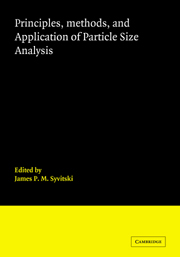Book contents
- Frontmatter
- Contents
- List of contributors
- Preface
- Acknowledgments
- I Introduction
- 1 Principles and methods of geological particle size analysis
- 2 The effect of grain shape and density on size measurement
- 3 The effect of pretreatment on size analysis
- II Theory and methods
- III In situ methods
- IV Data interpretation and manipulation
- V Applications
- Index
3 - The effect of pretreatment on size analysis
Published online by Cambridge University Press: 28 January 2010
- Frontmatter
- Contents
- List of contributors
- Preface
- Acknowledgments
- I Introduction
- 1 Principles and methods of geological particle size analysis
- 2 The effect of grain shape and density on size measurement
- 3 The effect of pretreatment on size analysis
- II Theory and methods
- III In situ methods
- IV Data interpretation and manipulation
- V Applications
- Index
Summary
Introduction
A commonly held assumption in particle size analysis is that the sample consists of discrete separate grains. The validity of this assumption for naturally occurring earth materials is questionable, and under certain circumstances it is not even desirable to consider them as separate grains. A significant mode of sediment transport is in the form of aggregates. Aggregates develop as part of the soil-forming processes; however, organic binding by fungi, filter feeders, and burrowing organisms are locally important during sediment transportation and deposition.
An aggregate particle, or “ped,” is defined here as consisting of two or more primary particles (produced by the weathering of rock) bound together by strong cohesive forces. Aggregates are stable under “normal” dispersive techniques such as stirring and dispersion with sodium hexametaphosphate. This definition eliminates such composite particles as floccules (unstable in “normal” dispersion) at one end of the spectrum and rock fragments (primary particle) at the other end.
Particle size analysis is generally utilized to interpret the conditions controlling the sample's occurrence (such as the provenance area or the physical/chemical conditions of erosion/transport/deposition), or for description/comparison. Sample handling, and the application of a particular pretreatment technique, may lead to modification of the grain size distribution in either a beneficial or a deleterious manner. Almost every sample collected for size analysis is pretreated. In some cases the treatment may be relatively gentle, such as stirring the sample in water, or even mild agitation/rubbing to ensure dispersion and destruction of any lumps formed during sample storage.
Information
- Type
- Chapter
- Information
- Publisher: Cambridge University PressPrint publication year: 1991
Accessibility standard: Unknown
Why this information is here
This section outlines the accessibility features of this content - including support for screen readers, full keyboard navigation and high-contrast display options. This may not be relevant for you.Accessibility Information
- 6
- Cited by
